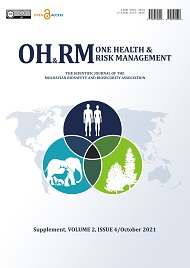Abstract
Introduction. Biosafety and biosecurity are related values, both protecting individuals and societies from harm arising from biological agents. Microbiological Labs are on the front line for the identification of outbreaks of emerging infectious diseases. The emergence of newly identified pathogens, as well as the re-emergence of pathogens with public health significance, exacerbates the global threat of infectious diseases. Public health laboratories protect the public’s health by providing services to prepare for and respond to all hazard threats. Therefore, these laboratories require proper biosafety and biosecurity preventive strategies to protect staff health from pathogenic infection.
Material and methods. The objective of the study was to carry out a bibliographic analysis of the literature related biosafety and biosecurity in laboratories. The paper analyzes the most relevant publications using Google Academic and Pubmed databases.
Results. Analyzed studies in recent years mentioned that microbiological laboratories is special work environments that may pose special infectious disease risks to persons in or near them. The integration of biosafety and biosecurity into one risk management framework as well as the adoption of new governance concepts building on organizational culture might provide suitable ways forward in developing a consistent global approach.
The scientific analyzed papers showed that the capacity of a microbiological lab to effectively respond to threats is based in its infrastructure: a highly skilled workforce, modern equipment and advanced technologies, facilities that ensure safety and security of lab workers and society as a whole. At the core of this effective response is a comprehensive quality management system with biosafety and biosecurity practices vital to every function. Responsible laboratory practices, protection, control and accountability for valuable biological materials will help prevent their unauthorized access, loss, theft, misuse or intentional release. In this context, it is essential that laboratory and service staff have the skills required to work safely in the lab.
In fact, the provision of a healthy and safe laboratory working environment has become the cornerstone in laboratory practices were highlighted in analyzed papers
Appropriate biorisk management measures tailored to specific facility needs allow the development and implementation of cost-effective, performance-based protection systems.
In fact, the provision of a healthy and safe laboratory working environment has become the cornerstone in laboratory practices were highlighted in analyzed papers.
Conclusions. Biosafety and biosecurity, refers to the implementation of laboratory practices and procedures, specific construction features of laboratory facilities, safety equipment, and appropriate occupational health programs when working with potentially infectious pathogens and other biological hazards. There is a need to implement the biosafety/biosecurity culture in all types of laboratories: microbiology, mycology, bacteriology, and virology.
|
 Views: 161|
|
Views: 161|
|
This work is licensed under a Creative Commons Attribution 4.0 International License.

